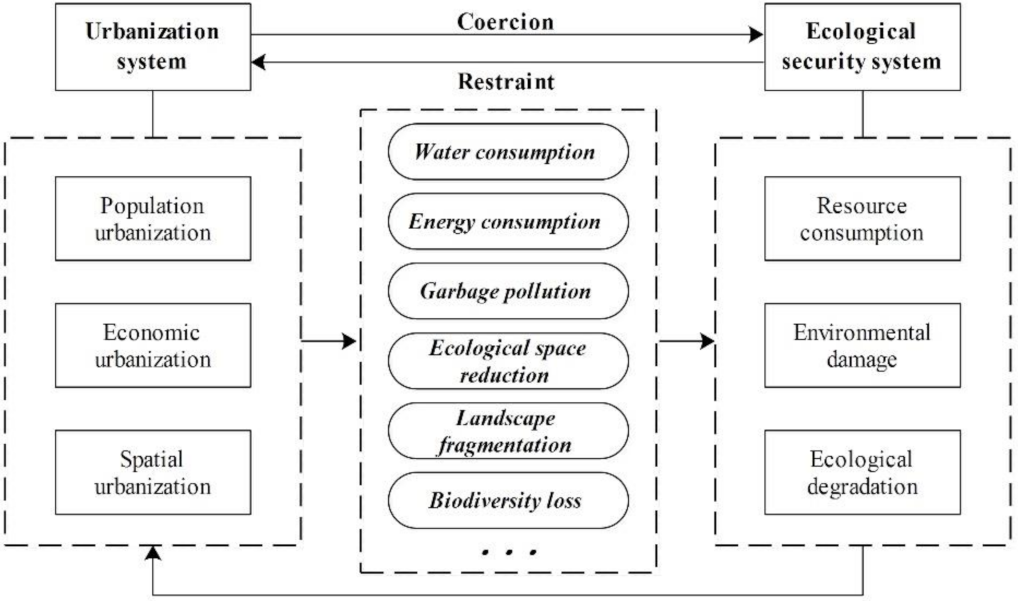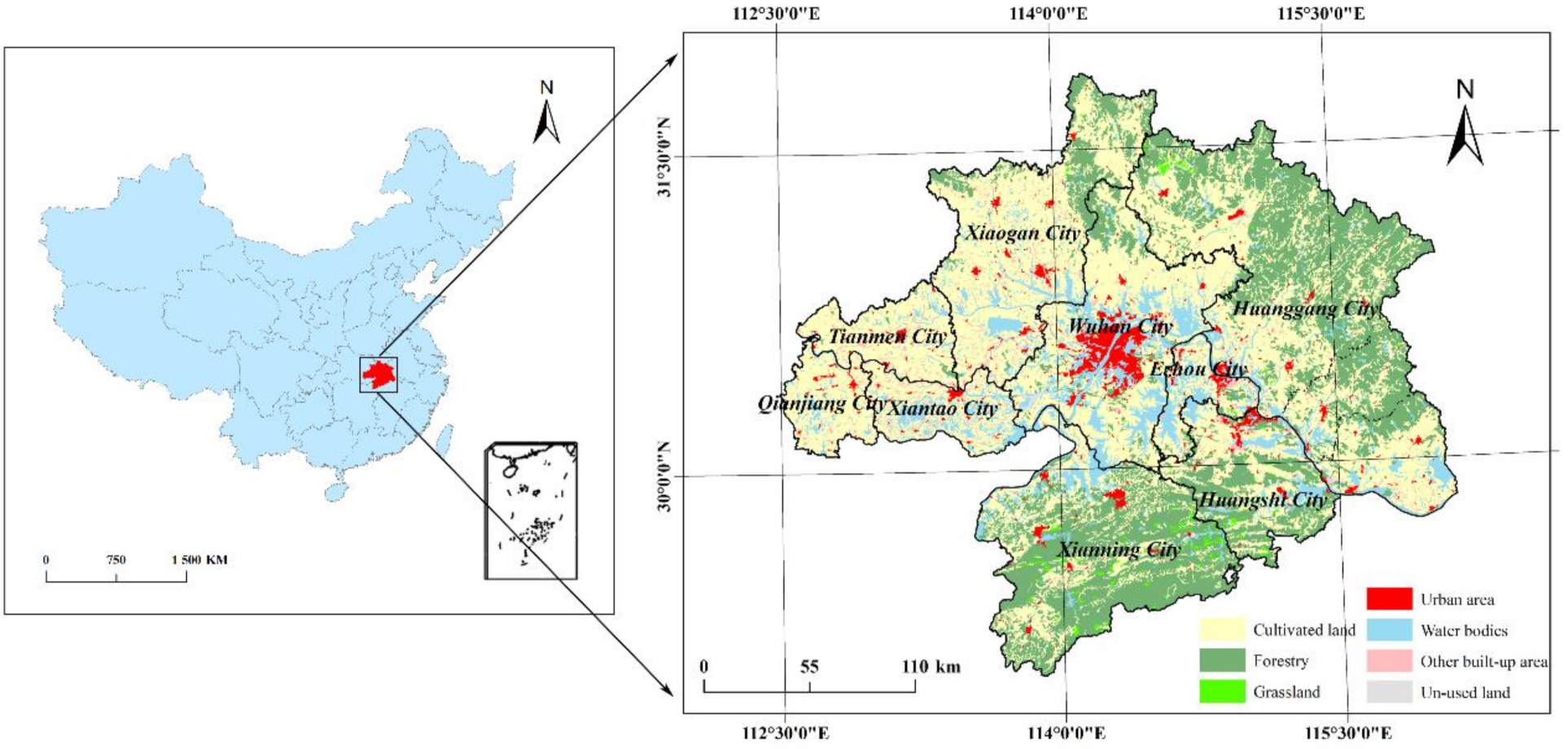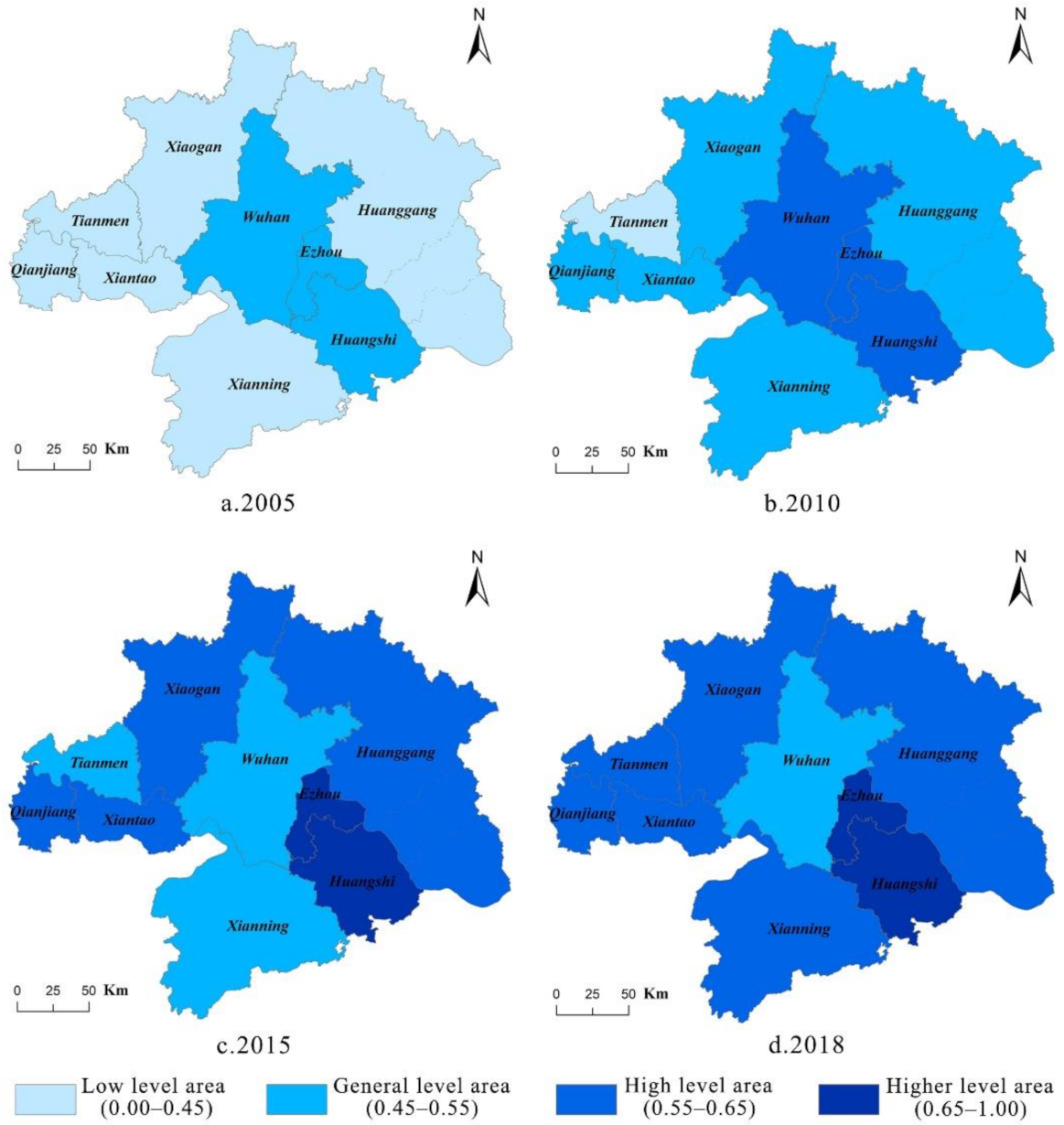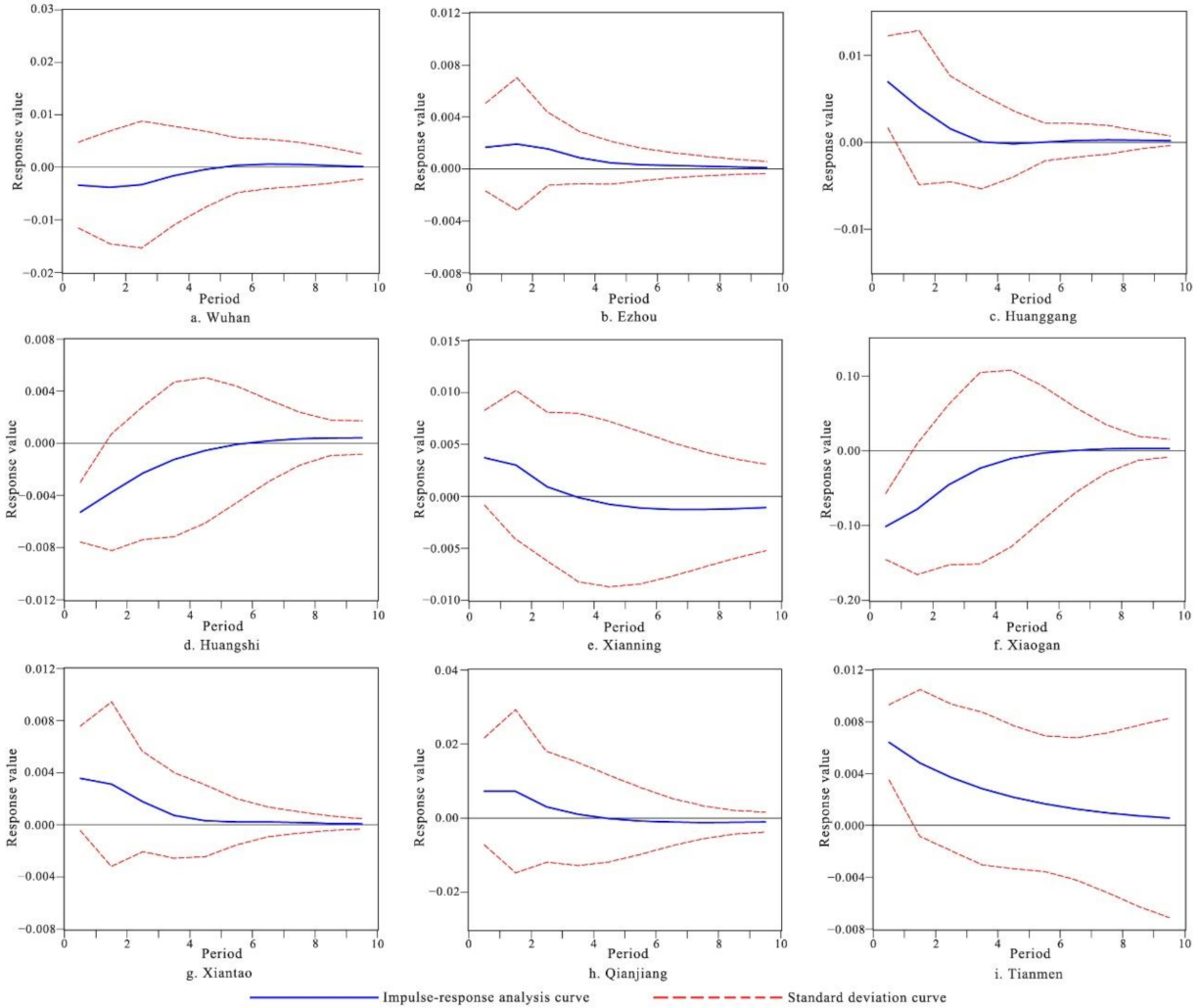Analysis for the Interaction Relationship between Urbanization and Ecological Security: A Case Study in Wuhan City Circle of China
Abstract
:1. Introduction
2. Theoretical Mechanism Analysis
2.1. The Connotation of Urbanization and Ecological Security
2.2. The Interaction between Urbanization and Ecological Security
3. Study Area and Data Sources
3.1. Study Area
3.2. Data Sources
4. Methods
4.1. Comprehensive Evaluation of Urbanization and Ecological Security
4.1.1. Data Standardization and Indicator Empowerment
4.1.2. Urbanization and Ecological Security Evaluation Index System
4.1.3. TOPSIS Model
4.2. Coupling Coordination Model
4.3. Vector Auto-Regression Model
5. Results
5.1. Variation Tendency of Urbanization in Wuhan City Circle
5.2. Variation Tendency of Ecological Security in Wuhan City Circle
5.3. Coupling Coordination Analysis of Urbanization and Ecological Security
5.4. Analysis of Dynamic Effects between Urbanization and Ecological Security in Wuhan City Circle
6. Discussion
6.1. The Interaction Mechanism between Urbanization and Ecological Security
6.2. Policy Implications of Coupling Coordination Analysis and Impulse Analysis
6.3. Limitations of the Present Study
7. Conclusions
Author Contributions
Funding
Institutional Review Board Statement
Informed Consent Statement
Data Availability Statement
Conflicts of Interest
References
- Department of Economic and Social Affairs of the United Nations (DESA). World Urbanization Prospects, the 2018 Revision; United Nations: New York, NY, USA, 2019; pp. 12–13. [Google Scholar]
- Grimm, N.B.; Faeth, S.H.; Golubiewski, N.E.; Redman, C.L.; Wu, J.G.; Bai, X.M.; Briggs, J.M. Global Change and the Ecology of Cities. Science 2008, 319, 756–760. [Google Scholar] [CrossRef] [PubMed] [Green Version]
- Tratalos, J.; Fuller, R.A.; Warren, P.H.; Davies, R.G.; Gaston, K.J. Urban form, biodiversity potential and ecosystem services. Landsc. Urban Plan. 2007, 83, 308–317. [Google Scholar] [CrossRef]
- Cui, X.G.; Fang, C.L.; Liu, H.M.; Liu, X.F. Assessing sustainability of urbanization by a coordinated development index for an Urbanization-Resources-Environment complex system: A case study of Jing-Jin-Ji region. China Ecol. Indic. 2019, 96, 383–391. [Google Scholar] [CrossRef]
- Chen, M.X.; Liu, W.D.; Tao, X.L. Evolution and assessment on China’s urbanization 1960–2010: Under-urbanization or over-urbanization? Habitat Int. 2013, 38, 25–33. [Google Scholar] [CrossRef]
- Schneider, A.; Mertes, C.M.; Tatem, A.J.; Tan, B.; Sulla-Menashe, D.; Graves, S.J.; Patel, N.N.; Horton, J.A.; Gaughan, A.E.; Rollo, J.T.; et al. A new urban landscape in East–Southeast Asia, 2000–2010. Environ. Res. Lett. 2015, 10, 1–14. [Google Scholar] [CrossRef]
- Peng, J.; Tian, L.; Liu, Y.X.; Zhao, M.Y.; Hu, Y.N.; Wu, J.S. Ecosystem services response to urbanization in metropolitan areas: Thresholds identification. Sci. Total Environ. 2017, 607, 706–714. [Google Scholar] [CrossRef]
- Zhu, M.C.; Shen, L.Y.; Tam, V.W.Y.; Liu, Z.; Shu, T.H. A load-carrier perspective examination on the change of ecological environment carrying capacity during urbanization process in China. Sci. Total Environ. 2020, 714, 136843. [Google Scholar] [CrossRef]
- Wu, J.G.; Xiang, W.N.; Zhao, J.Z. Urban ecology in China: Historical developments and future directions. Landsc. Urban Plan. 2014, 125, 222–233. [Google Scholar] [CrossRef]
- Long, H.L.; Liu, Y.Q.; Hou, X.G.; Li, T.T.; Li, Y.R. Effects of land use transitions due to rapid urbanization on ecosystem services: Implications for urban planning in the new developing area of China. Habitat Int. 2014, 44, 536–544. [Google Scholar] [CrossRef]
- Ahmed, Z.; Asghar, M.M.; Malik, M.N.; Nawaz, K. Moving towards a sustainable environment: The dynamic linkage between natural resources, human capital, urbanization, economic growth, and ecological footprint in China. Resour. Policy 2020, 67, 101677. [Google Scholar] [CrossRef]
- Shen, L.; Cheng, S.K.; Gunson, A.J.; Hui, W. Urbanization, sustainability and the utilization of energy and mineral resources in China. Cities 2005, 22, 287–302. [Google Scholar] [CrossRef]
- Gollin, D.; Jedwab, R.; Vollrath, D. Urbanization with and without industrialization. J. Econ. Growth 2016, 21, 35–70. [Google Scholar] [CrossRef]
- Chen, Y.C. Effects of urbanization on municipal solid waste composition. Waste Manag. 2018, 79, 828–836. [Google Scholar] [CrossRef] [PubMed]
- Wang, Y.N.; Li, X.B.; Kang, Y.Q.; Chen, W.; Zhao, M.J.; Li, W. Analyzing the impact of urbanization quality on CO2 emissions: What can geographically weighted regression tell us? Renew. Sustain. Energ. Rev. 2019, 104, 127–136. [Google Scholar] [CrossRef]
- Liu, Y.H.; Gao, C.C.; Lu, Y.Y. The impact of urbanization on GHG emissions in China: The role of population density. J. Clean. Prod. 2017, 157, 299–309. [Google Scholar] [CrossRef]
- Deng, X.Z.; Huang, J.K.; Rozelle, S.; Zhang, J.P.; Li, Z.H. Impact of urbanization on cultivated land changes in China. Land Use Policy 2015, 45, 1–7. [Google Scholar] [CrossRef]
- Ren, L.J.; Cui, E.Q.; Sun, H.Y. Temporal and spatial variations in the relationship between urbanization and water quality. Environ. Sci. Pollut. Res. 2014, 21, 13646–13655. [Google Scholar] [CrossRef] [PubMed]
- Fang, C.L.; Cui, X.G.; Li, G.D.; Bao, C.; Wang, Z.B.; Ma, H.T.; Sun, S.A.; Liu, H.M.; Luo, K.; Ren, Y.F. Modeling regional sustainable development scenarios using the Urbanization and Eco-environment Coupler: Case study of Beijing-Tianjin-Hebei urban agglomeration, China. Sci. Total Environ. 2019, 689, 820–830. [Google Scholar] [CrossRef]
- Fang, C.L.; Wang, J. A theoretical analysis of interactive coercing effects between urbanization and eco-environment. Chin. Geogr. Sci. 2013, 23, 147–162. [Google Scholar] [CrossRef]
- Zhou, D.; Lin, Z.L.; Ma, S.M.; Qi, J.L.; Yan, T.T. Assessing an ecological security network for a rapid urbanization region in Eastern China. Land Degrad. Dev. 2021, 32, 2642–2660. [Google Scholar] [CrossRef]
- Tian, Y.S.; Wang, L. The Effect of Urban-Suburban Interaction on Urbanization and Suburban Ecological Security: A Case Study of Suburban Wuhan, Central China. Sustainability 2020, 12, 1600. [Google Scholar] [CrossRef] [Green Version]
- Cui, X.G.; Fang, C.L.; Liu, H.M.; Liu, X.F.; Li, Y.H. Dynamic simulation of urbanization and eco-environment coupling: Current knowledge and future prospects. J. Geogr. Sci. 2020, 30, 333–352. [Google Scholar] [CrossRef]
- Liu, W.J.; Jiao, F.C.; Ren, L.J.; Xu, X.G.; Wang, J.C. Coupling coordination relationship between urbanization and atmospheric environment security in Jinan City. J. Clean. Prod. 2018, 204, 1–11. [Google Scholar] [CrossRef]
- Ariken, M.; Zhang, F.; Liu, K.; Fang, C.L.; Kuang, H.T. Coupling coordination analysis of urbanization and eco-environment in Yanqi Basin based on multi-source remote sensing data. Ecol. Indic. 2020, 114, 106331. [Google Scholar] [CrossRef]
- Tian, L.; Xu, G.F.; Fan, C.J.; Zhang, Y.; Gu, C.L.; Zhang, Y. Analyzing Mega City-Regions through Integrating Urbanization and Eco-Environment Systems: A Case Study of the Beijing-Tianjin-Hebei Region. Int. J. Environ. Res. Public Health 2019, 16, 114. [Google Scholar] [CrossRef] [Green Version]
- Wang, Y.F.; Geng, Q.J.; Si, X.H.; Kan, L.P. Coupling and coordination analysis of urbanization, economy and environment of Shandong Province, China. Environ. Dev. Sustain. 2021, 23, 10397–10415. [Google Scholar] [CrossRef]
- Lin, S.F.; Sun, J.; Marinova, D.; Zhao, D.T. Effects of Population and Land Urbanization on China’s Environmental Impact: Empirical Analysis Based on the Extended STIRPAT Model. Sustainability 2017, 9, 825. [Google Scholar] [CrossRef] [Green Version]
- Wang, Z.B.; Liang, L.W.; Sun, Z.; Wang, X.M. Spatiotemporal differentiation and the factors influencing urbanization and ecological environment synergistic effects within the Beijing-Tianjin-Hebei urban agglomeration. J. Environ. Manag. 2019, 243, 227–239. [Google Scholar] [CrossRef]
- Qiu, M.; Yang, Z.L.; Zuo, Q.T.; Wu, Q.S.; Jiang, L.; Zhang, Z.Z.; Zhang, J.W. Evaluation on the relevance of regional urbanization and ecological security in the nine provinces along the Yellow River, China. Ecol. Indic. 2021, 132, 108346. [Google Scholar] [CrossRef]
- Liu, N.N.; Liu, C.Z.; Xia, Y.F.; Da, B.W. Examining the coordination between urbanization and eco-environment using coupling and spatial analyses: A case study in China. Ecol. Indic. 2018, 93, 1163–1175. [Google Scholar] [CrossRef]
- Li, Y.F.; Li, Y.; Zhou, Y.; Shi, Y.L.; Zhu, X.D. Investigation of a coupling model of coordination between urbanization and the environment. J. Environ. Manag. 2012, 98, 127–133. [Google Scholar] [CrossRef]
- Xu, L.Y.; Yin, H.; Li, Z.X.; Li, S. Land Ecological Security Evaluation of Guangzhou, China. Int. J. Environ. Res. Public Health 2014, 11, 10537–10558. [Google Scholar] [CrossRef] [PubMed] [Green Version]
- Hubei Provincial Bureau of Statistics (HPBS). Hubei Statistical Yearbook of 2019; China Statistical Press: Beijing, China, 2019; pp. 4–96. [Google Scholar]
- Resource and Environment Science and Data Center. Available online: http://www.resdc.cn/ (accessed on 10 July 2021).
- Department of Ecology and Environment of Hubei Province. Available online: http://sthjt.hubei.gov.cn/hjsj/ (accessed on 12 July 2021).
- Ministry of Housing and Urban-Rural Development of the People’s Republic of China. Available online: http://www.mohurd.gov.cn/gongkai/fdzdgknr/sjfb/tjxx/ (accessed on 15 July 2021).
- Hubei Provincial Statistics Bureau. Available online: http://tjj.hubei.gov.cn/tjsj/ (accessed on 16 July 2021).
- Costanza, R.; d’Arge, R.; de Groot, R.; Farber, S.; Grasso, M.; Hannon, B.; Limburg, K.; Naeem, S.; ONeill, R.V.; Paruelo, J.; et al. The value of the world’s ecosystem services and natural capital. Nature 1997, 387, 253–260. [Google Scholar] [CrossRef]
- Xie, G.D.; Zhang, C.X.; Zhen, L.; Zhang, L.M. Dynamic changes in the value of China’s ecosystem services. Ecosyst. Serv. 2017, 26, 146–154. [Google Scholar] [CrossRef]
- Xiao, R.; Liu, Y.; Fei, X.F.; Yu, W.X.; Zhang, Z.H.; Meng, Q.X. Ecosystem health assessment: A comprehensive and detailed analysis of the case study in coastal metropolitan region, eastern China. Ecol. Indic. 2019, 98, 363–376. [Google Scholar] [CrossRef]
- Cong, R.G.; Wei, Y.M.; Jiao, J.L.; Fan, Y. Relationships between oil price shocks and stock market: An empirical analysis from China. Energ. Policy 2008, 36, 3544–3553. [Google Scholar] [CrossRef]








| Target Layer | Subsystem Layer and Weight | Indicator Layer | Entropy Weight | Indicator Type |
|---|---|---|---|---|
| Urbanization | Population urbanization (0.2234) | Proportion of non-agricultural population (%) | 0.1327 | + |
| Urban population density (people/km2) | 0.0907 | + | ||
| Economic urbanization (0.3590) | Per capita GDP (yuan/people) | 0.0929 | + | |
| The proportion of the secondary and tertiary industries in GDP (%) | 0.0608 | + | ||
| Per capita total retail sales of social consumer goods (yuan/people) | 0.0905 | + | ||
| Per capita fiscal revenue (yuan/people) | 0.1148 | + | ||
| Spatial urbanization (0.4176) | The proportion of built-up area to total urban area (%) | 0.1026 | + | |
| Per capita urban road area (m2/people) | 0.0571 | + | ||
| Per land output value of secondary and tertiary industries (10,000 yuan/km2) | 0.1321 | + | ||
| Per land fixed asset investment (10,000 yuan/km2) | 0.1258 | + | ||
| Ecological security | Resource (0.2804) | Per capita daily domestic water consumption (L/people·day) | 0.0387 | − |
| Change rate of unit GDP energy consumption (%) | 0.0281 | − | ||
| Per capita built-up area (m2/people) | 0.1463 | − | ||
| Unit GDP water consumption (t/10,000 yuan) | 0.0673 | − | ||
| Environment (0.2446) | Wastewater discharge intensity (t/km2) | 0.0748 | − | |
| Green coverage rate in built-up area (%) | 0.0310 | − | ||
| Per capita park green area (m2/people) | 0.0526 | + | ||
| Good air quality rate (%) | 0.0862 | + | ||
| Ecology (0.4750) | Patch density | 0.0762 | − | |
| Ecosystem service value (yuan) | 0.1956 | + | ||
| Ecological resilience index | 0.2032 | + |
| Ecosystem Type | Equivalent Value | Ecosystem Type | Equivalent Value |
|---|---|---|---|
| Paddy land | 3.89 | Grassland | 12.06 |
| Dry land | 4.01 | Water bodies | 125.61 |
| Shrub land | 15.22 | Built-up area | 0 |
| Other forest | 21.19 | Unused land | 0.65 |
| Land-Use Type | Resilience | Land-Use Type | Resilience |
|---|---|---|---|
| Urban area | 0 | Flood land | 5 |
| Rural residential area | 1 | River | 6 |
| Un-used land | 2 | Reservoir and lakes | 7 |
| Dry land | 3 | Grass land | 8 |
| Paddy land | 4 | Forestry | 9 |
| Type | Coupling Coordination Degree | Subtype | Explanation |
|---|---|---|---|
| Advanced coordination | Advanced coordination: urbanization lag | ||
| Advanced coordination: ecological security lag | |||
| Advanced coordination | |||
| Basic coordination | Basic coordination: urbanization lag | ||
| Basic coordination: ecological security lag | |||
| Basic coordination | |||
| Basic un-coordination | Basic un-coordination: urbanization blocked | ||
| Basic un-coordination: ecological security blocked | |||
| Basic un-coordination | |||
| Serious un-coordination | Serious un-coordination: urbanization blocked | ||
| Serious un-coordination: ecological security blocked | |||
| Basic un-coordination |
| Variables 1 | ADF T-Statistics | Critical Value at Significant Level | Results | ||
|---|---|---|---|---|---|
| 5% | 10% | 5% | |||
| of Wuhan city | −4.4253 | −4.2970 | −3.2126 | −2.7476 | Stationarity |
| of Wuhan city | −3.0452 | −4.2000 | −3.1753 | −2.7289 | Stationarity |
| of Ezhou city | −3.2276 | −4.2000 | −3.1753 | −2.7289 | Stationarity |
| of Ezhou city | −3.0403 | −4.2000 | −3.1753 | −2.7289 | Stationarity |
| of Huanggang city | −2.7414 | −4.2000 | −3.1753 | −2.7289 | Stationarity |
| of Huanggang city | −3.0247 | −4.2000 | −3.1753 | −2.7289 | Stationarity |
| of Huangshi city | −3.4067 | −4.2000 | −3.1753 | −2.7289 | Stationarity |
| of Huangshi city | −3.1548 | −4.2000 | −3.1753 | −2.7289 | Stationarity |
| of Xianning city | −2.8865 | −4.2000 | −3.1753 | −2.7289 | Stationarity |
| of Xianning city | −3.5927 | −4.2000 | −3.1753 | −2.7289 | Stationarity |
| of Xiaogan city | −3.5427 | −4.2000 | −3.1753 | −2.7289 | Stationarity |
| of Xiaogan city | −3.0515 | −4.2000 | −3.1753 | −2.7289 | Stationarity |
| of Xiantao city | −3.1562 | −4.2000 | −3.1753 | −2.7289 | Stationarity |
| of Xiantao city | −3.0085 | −4.2000 | −3.1753 | −2.7289 | Stationarity |
| of Qianjiang city | −4.9535 | −4.2970 | −3.2126 | −2.7476 | Stationarity |
| of Qianjiang city | −3.3523 | −4.2000 | −3.1753 | −2.7289 | Stationarity |
| of Tianmen city | −3.3268 | −4.2000 | −3.1753 | −2.7289 | Stationarity |
| of Tianmen city | −3.3887 | −4.2000 | −3.1753 | −2.7289 | Stationarity |
Publisher’s Note: MDPI stays neutral with regard to jurisdictional claims in published maps and institutional affiliations. |
© 2021 by the authors. Licensee MDPI, Basel, Switzerland. This article is an open access article distributed under the terms and conditions of the Creative Commons Attribution (CC BY) license (https://creativecommons.org/licenses/by/4.0/).
Share and Cite
Chai, J.; Wang, Z.; Yu, C. Analysis for the Interaction Relationship between Urbanization and Ecological Security: A Case Study in Wuhan City Circle of China. Int. J. Environ. Res. Public Health 2021, 18, 13187. https://doi.org/10.3390/ijerph182413187
Chai J, Wang Z, Yu C. Analysis for the Interaction Relationship between Urbanization and Ecological Security: A Case Study in Wuhan City Circle of China. International Journal of Environmental Research and Public Health. 2021; 18(24):13187. https://doi.org/10.3390/ijerph182413187
Chicago/Turabian StyleChai, Ji, Zhanqi Wang, and Chen Yu. 2021. "Analysis for the Interaction Relationship between Urbanization and Ecological Security: A Case Study in Wuhan City Circle of China" International Journal of Environmental Research and Public Health 18, no. 24: 13187. https://doi.org/10.3390/ijerph182413187
APA StyleChai, J., Wang, Z., & Yu, C. (2021). Analysis for the Interaction Relationship between Urbanization and Ecological Security: A Case Study in Wuhan City Circle of China. International Journal of Environmental Research and Public Health, 18(24), 13187. https://doi.org/10.3390/ijerph182413187






